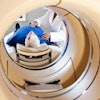
Africa desperately needs more radiologists, but Aga Khan University in Nairobi, Kenya, has staked its claim on quality rather than quantity, according to a presentation at the 2014 Arab Health Meeting in Dubai, United Arab Emirates.
According to Dr. Sudhir Vinayak, chair of the university's radiology department, the main problem that comes with having the continent's best-trained residents is keeping them in Africa. But there are initiatives in place to try to accomplish that, he said. Vinayak's department focuses on training the best of a new generation of top-notch African radiologists who are as comfortable in London as they are in Nairobi.
"In East Africa, there are about 100 million inhabitants, and [regional universities] train just 25 to 30 radiologists a year; that's about one radiologist for every 400,000 residents," Vinayak said. "There is pressure [from the government] to train more radiologists in a shorter period of time as we need more radiologists. To them, numbers are important, the quality is not."
 Dr. Sudhir Vinayak from Aga Khan University.
Dr. Sudhir Vinayak from Aga Khan University.
However, bigger numbers are what the region's public universities do best. As East and Central Africa's premiere radiology center, the private, nonprofit Aga Khan has a different and very important mission, according to Vinayak.
"The question is: In such an environment, can we train radiologists to international standards?" he said. "Our response has been a simple one, and that is that quality is important, numbers are not."
Aga Khan's radiology training program starts with very strict admission criteria that are blind to position and influence.
For example, admission doesn't depend on who the applicant is or knows, only on the strength of the candidate. "We have very strict criteria for intake based purely on merit -- nobody has any influence," Vinayak said.
The four-year intensive course leads to a Master of Medicine degree in radiology, he said. Residents must write a dissertation and complete a research project that is published in an international journal. There is an exam at the end of each year and two exams in the fourth year. Teaching is self-directed using a problem-based approach, and residents experience monthly rotations in the various modalities, Vinayak said.
Aga Khan's radiology department hosts weekly film interpretation sessions, multidisciplinary meetings, and resident-driven case interpretation sessions, he said. There are daily presentations by first-year residents on anatomy and radiology procedures, and these are critiqued by faculty.
Lectures and tests
In addition, common courses for all residents are taught in the following:
- Epidemiology and biostatistics
- Bioethics and jurisprudence
- Information technology
- Introduction to medical education
- Health management
- Research methods
"This is in addition to introduction to medical radiology," Vinayak said. "They all need to sit through these."
Then comes an alphabet soup of written exams for various stages of training. A structured reporting image exam (SIRE), a multiple choice question (MCQ) exam, and a modified essay question (MEQ) exam are all given monthly.
First-year residents are tested in physics, radiological anatomy, and procedures (MCQ), and first- and fourth-year residents take mock exams (MCQ, MEQ, and SIRE).
"We just published a paper on SIRE to try to hopefully get some kind of international acceptance; the people who have looked at it think it's a very unique exam," Vinayak said. "It's basically an image reporting exam that can be replicated simultaneously."
The flurry of exams ends with yet another acronym: the mutually agreed statement of training (MOST), which is completed by the researcher, discussed with the department representative, and signed off by the president, Vinayak said.
Along with testing comes workplace-based assessment, used at Aga Khan as a formative assessment tool. These include the Mini-IPX (image interpretation exercise) and the Rad-DOPS (direct observation of procedural skills).
"All of the residents are grilled every four months," and multisource feedback occurs every six months, Vinayak said. All residents are appraised based on documented feedback and performance every four months to generate an interim summary assessment and summary of feedback (ISASF), which determines their next level of training.
"If we find they haven't done that well in three to four months, they're going to repeat it," Vinayak said.
Training is tied inexorably with learning. Knowledge is the lowest level of training, which forms the basis of all communication, but simply being able to recall knowledge isn't enough, Vinayak explained. "You have to be able to apply it, transferring existing knowledge and skills to new situations," he said.
Feedback is a core component of this evolution of knowledge in the department, he said. Feedback should be seen as a normal, everyday part of the training process. Learners should be clear about the criteria they are being evaluated on, and feedback should be provided on specific behaviors.
"Just saying you're doing well is not good enough," Vinayak said. Feedback "should be based on what's directly observed and not hearsay, and it should be given at the time of the event or shortly thereafter. ... And you need to listen to what they say -- this should not be a one-direction conversation. If you have a real problem resident, handle it first and then handle the rest."
Accreditation and careers
"The proof of the pudding is in the tests," Vinayak said. International accreditation is how you see how well the residents have done. Exams, parts I and II, are conducted and approved by the chief internal examiner, usually the head of the department, and then by the regional East African examiner. Finally, they are approved by a chief external examiner, who must be a member of an internationally accredited board.
"We have focused on training to international standards," Vinayak said. "We're taking three residents and we have 150 applications, so we pick the best. All of our residents go on to do their fellowships in the U.K. and the U.S., and as soon as their fellowships are complete, they sit for the Royal College exam, and to date nobody has failed. So the challenge in Africa is how we are going to retain these people, because we have standards, and it makes it very difficult to retain them."
The department has strong ties with the U.K.'s Oxford University, the University of Toronto in Canada, and Johns Hopkins University in Baltimore, he said.
An audience member challenged Vinayak on his standards, saying that because Africa is so desperate for radiologists, the focus should be on generating volume rather than training a very few great radiologists.
Vinayak responded that for Aga Khan it's important to have the best, even if the institution is producing only three radiologists a year. After all, he said, there are universities in the region that "give in to the demands of the government" for higher numbers and produce eight to 10 very good radiologists each year.
"I think the real numbers are going to come from the public universities, but we are trying to produce the best," he said.



















